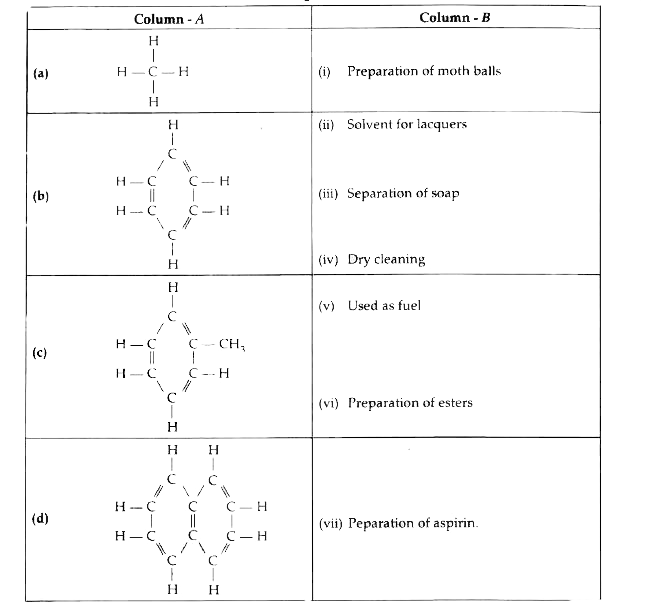Explain the following reactions with one example for each giving relevant chemical equations : (i) Hydrogenation reaction,
(ii) Oxidation reaction,
(iii) Substitution reaction,
(iv) Saponification reaction.Solution in Kannada
(i) Hydrogenation reaction It is the process in which unsaturated compound reacts with hydrogen in presence of nickel as a catalyst to form saturated compound.

(ii) Oxidation reaction : When there is an addition of oxygen in the reaction, it is known as oxidation reaction.
CH3CH2OHEthanol+[O]Alkalana−−−−→KMnOCH3COOH+H2OEthanoic acid
(iii) Substitution reaction. Those reactions in which an atom or group of atoms of compound are replaced by other atom or group of atoms are called substitution reactions.
CH4(g)Mathane+CI2(g)Chlorine+[O]sunlight−−−−→CH3CI(g)Chloromethane+HCI(g) Hydrogen chloride
(iv) Saponification reaction: lt is the reaction in which an ester reacts with sodium hydroxide to form sodium salts of acid and alcohol.
CH3COOC2H5Ethyl ethanote+NaOHSodium hydroxideCH3COONa+Sodium ethanoate−−−−→C2H5OHEthanola
Topper's Solved these Questions
- CARBON AND ITS COMPOUNDSBook:OSWAAL PUBLICATIONChapter:CARBON AND ITS COMPOUNDSExercise:Topic II- Carbon Compounds , Soap and Detergents (Multiple Choice Question)
Explore 2 Videos
- CARBON AND ITS COMPOUNDSBook:OSWAAL PUBLICATIONChapter:CARBON AND ITS COMPOUNDSExercise:Topic II- Carbon Compounds , Soap and Detergents (Match the Column)
Explore 1 Video
- CARBON AND ITS COMPOUNDSBook:OSWAAL PUBLICATIONChapter:CARBON AND ITS COMPOUNDSExercise:Topic I- Carbon and its Properties, Homologous Series and IUPAC Names (Short Answer Type Ouestions-II)
Explore 23 Videos
- ACIDS,BASES AND SALTS Book:OSWAAL PUBLICATIONChapter:ACIDS,BASES AND SALTS Exercise:NCERT CORNER TEXTBOOK EXERCISES
Explore 15 Videos
- CHEMICAL REACTIONS AND EQUATIONSBook:OSWAAL PUBLICATIONChapter:CHEMICAL REACTIONS AND EQUATIONSExercise:NCERT CORNER (Textbook Exercises)
Explore 20 Videos
Similar Questions
Select a sweet smelling compound out of the following:
View SolutionThe structural formulae of hvdrocarbons are given in Column-A and their uses are given in Column-B.

View SolutionWhat are covalent compounds ? Why are they different from ionic compounds ? List their three characteristics.
View SolutionA solution turns red litmus blue, its pH is likely to be
View SolutionWhich of the statements about the reaction below are incorrect ?
2PbO(s)+C(s)→2Pb(s)+CO2(g)
View SolutionExplain the given reactions with the examples. (a) Hydrogenation reaction , (b) Oxidation reaction (c ) Substitution reaction , (d) Saponification reaction (e) Combustion reaction
View SolutionGive one example each of :
(i) Thermal decomposition reaction
(ii) Electrolytic decomposition reaction
(iii) Photo decomposition reaction.
View SolutionWrite chemical equation to represent each of the following types of reactions of organic substances.
(i) Esterification,
(ii) Saponification
(iii) Substitution.
View Solutionकिन्हीं दो अभिक्रिया को उदाहरण सहित समझाइए :
(i) संकलन अभिक्रिया
(ii) प्रतिस्थापन अभिक्रिया
(ii) ऑक्सीकरण अभिक्रिया
(iv) दहन अभिक्रिया
View Solutionनिंम्न को उदहारण देकर समजाहिए:
(i) संकलन अभिक्रिया
(ii) प्रतिस्थापन अभिक्रिया
View SolutionExplain the following with examples : (i) Tetravalency (ii) Substitution reaction (iii) Addition reaction (iv) Combustion
View Solutionनिम्नलिखित की व्याख्या करें-
( i ) प्रतिस्थापन अभिक्रिया (ii) योगशील अभिक्रिया
(iii) विलोपन अभिक्रिया (iv) मारकोनीकॉव नियम
View Solutionनिम्न को उदाहरण देकर समझाइए -
(i) संकलन अभिक्रिया (ii) प्रतिस्थापन अभिक्रिया
View SolutionGive one example to the following reactions.
(i) Swarts reaction.
(ii) Wurtz-Fittig reaction.
(iii) Sandmeyer's reaction.
View Solutiona) Whatis an esterification reaction ? (b) Write a chemical equation in each case to represent the following types of chemical reaction of organic compounds : (i) Oxidation reaction (ii) Addition reaction (iii) Substitution reaction.
View SolutionExplain the following reactions with one example for each giving relevant chemical equations : (i) Hydrogenation reaction,
(ii) Oxidation reaction,
(iii) Substitution reaction,
(iv) Saponification reaction.
View Solution

